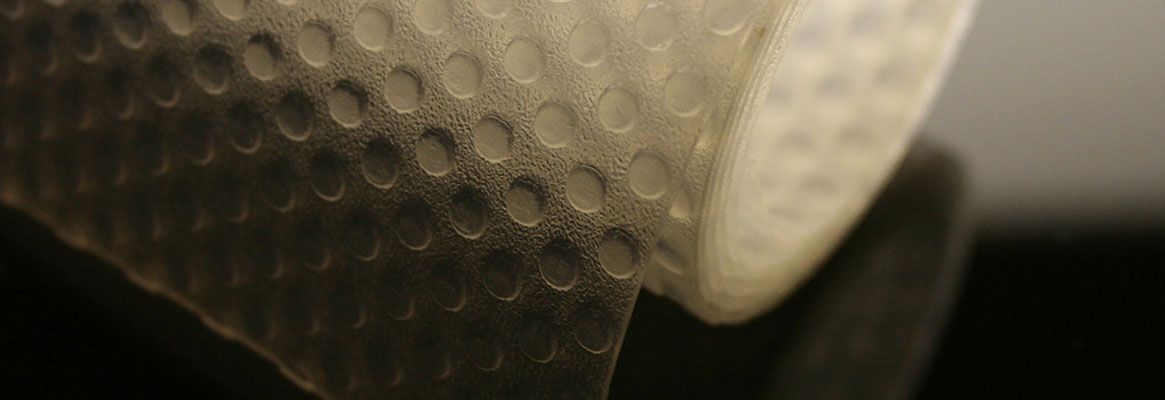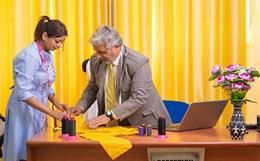Universidade do Minho, School of Engineering,Department of Textile Engineering Azurem - P-4800-058 GUIMARAES, Portugal
Abstract
Multifunctional effects are essential for producing higher value added textiles, important not only for new technical applications butalso for more "traditional" uses such as clothing and home textileswith high product differentiation. Within the "European TechnologyPlatform for the Future of Textiles and Clothing", functional textiles area clear priority. Surface modification by means of finishing is very versatileand allows a large number of effects. The developments of new functionaleffects also lead to the need of the development of specific test methods thatare able to measure the effectiveness, durability and toxicity of the claimedfunctionalities. The technical committee for "textiles and textileproducts" of the European Standardisation is now devoting specialattention to this subject.
Key words: Textiles, Functionalisation, Finishing,Effectiveness, Durability, Toxicity
1. Introduction
The consumers are demanding textile products with higherperformances, even in the traditional clothing and home textiles areas. Infact, significant product differentiation in the area of textiles can be achievedby high performance properties, in parallel with visual appearance. Some ofthese properties were developed mainly for "protective" clothing butnowadays they are often present in functional textiles used for "normal"clothing. Many fabric producers are devoting more and more attention to try toput into the market products with new effects that can represent an importantadded value [1].
Functional properties can be defined as all the effects thatare beyond the pure aesthetic and decorative functions. They include a largerange of properties that in some cases can be also classified as "smartproperties", which means that they grant to the textiles the capacity ofacting according to an external stimulation. Multiple functions are oftenrequired, leading to what we can call multifunctional textiles.
Functionalisation of textiles has been considered as one ofthe important topics to be included in the "European Technology Platformfor the Future of Textiles and Clothing" which is being developed with thecoordination of EURATEX with the scientific support of TEXTRANET and AUTEX. Aspecific group called: Functionalisation of textiles and related processes has been created, but the subject "functionality" or "functionalisationof textiles" appears in the reports presented by all the nine Thematic ExpertGroups which prepared the research agenda for the future.
2. Functionalisation of textiles
Functionalisation of textile materials can be defined as a process which provides functional properties to textile and clothing materials. Functional properties can be obtained either by:
- the fibre itself (characteristics of the polymer or additives before fibre spinning);
- yarn, fabric or material construction (for instance, with different fibres or different layers);
- textile finishing.
In this presentation, main emphasis will be given to thefunctionalisation of textiles achieved by means of the incorporation ofchemicals in fabric finishing. This can be made by all the traditionaltechnologies, such as: exhaustion, padding, low add-on processes, foamapplication, printing, coating, etc. The innovative effects are assured by theapplication of specialty chemicals which can be applied by means of newalternative supports, such as microencapsulation, by using cyclodextrines.These alternatives are now very important for the application of severalfunctional finishes, especially when a long term effect is intended, withcontrolled release of chemicals. The emergence of the so-called nanotechnologiesopens also a wide range of new possibilities.
In many cases, the functional properties involve a surfacemodification, which can be obtained by means of chemical modification, by theapplication of a surface layer or by more environmental friendly treatmentssuch as the use of enzymes or physical modification (based namely on plasma technology).
As already mentioned, functional textiles are considered as a clear priority within the "European Technology Platform for the Future of Textiles and Clothing". The Task Group "Functionalisation of Textiles and Related Processes" has made a detailed survey of the subject and considered a total of 44 topics as possible subjects for future developments in terms of Research and Development. Following the feed-back of a questionnaire sent to experts, twelve topics have been highlighted as having more economic relevance in the future. These include new functionalities, new processes, new additives/chemicals and also design and prototyping and have been included in the Research Agenda that has been proposed [2]. All the subjects have been clustered within larger research areas derived from the prioritized research subjects. These areas have been identified as follows:
2.1 Increasing flexibility and efficiency in product development
Answering exactly the demands of the customer within a short delay is a real challenge and new product development paradigms have to be found to develop fully integrated multifunctional textile products. If early in the product development process, the different experts involved (system, materials and process experts) work together, than it will be possible to design or tailor a textile product to meet the needs of the system.
New approaches to design products and to achieve high added value functionalities can be found by looking at nature. Bio mimicry or imitation of nature is a science that studies the natures models and then imitates or takes inspiration from these designs and processes to solve problems. Also textiles can take advantage of the very sophisticated and highly efficient mechanisms with which nature protects itself in hazardous environments, based on extraordinary functionalities.
2.2 More for less: functionalities for high performance materials.
The expectations of the consumers concerning the performance level of products, namely through multifunctional properties, are always increasing. Comfort of clothing systems is a very important and highly desirable characteristic which involves thermal insulation and active cooling.
Textile materials with controlled release properties can release chemicals in a controlled way. Often there is a continuous slow release of the chemicals but the release can also be envisaged upon a stimulus. The controlled release of chemicals can find many applications, not only in the cosmetic area, where several products are already commercially available, but also in medical applications for controlled release of drugs. The textile industry needs to look for new polymer systems which are today being studied in the labs, trying to put them quickly in the market.
Textile materials with biosensing or sensing properties in general are also possible routes to bring highly desirable new products. Textile materials can be equipped with molecular recognition properties. Molecular recognition systems are e.g. macrocycles such as calixarenes. A calixarene is a macrocycle or cyclic oligomer based on a hydroxyalkylation product of a phenol and an aldehyde. The word calixarene is derived from calix because this type of molecule resembles a vase and from the word arene that refers to the aromatic building block. This molecule has in fact the shape of a conical basket. The lower rim of the basket contains hydroxyl group in such a way that they can encapsulate various charged species via polar interactions.
2.3 Green, greener, greenest
Processes used for the functionalisation of textile materials need to be increasing environmentally friendly. The use of natural resources, energy, chemicals needs to be minimised.
Processes relying on ultra-violet (UV) radiation for curing and replacing the use of high temperature treatment are highly desirable. There is still need for UV curable coatings which do not affect the hand of textile materials.
Local functionalisation or functionalisation of textile materials "where this is needed" is a route for reducing the use of chemicals. This could be achieved through local deposition techniques such as digital printing, spraying, template techniques, etc. Also other potential techniques such as ion implantation, laser beam activation, could provide a pathway for local functionalisation.
The development of self cleaning textiles, which can be based the application of titanium dioxide on the surface, can have an important contribution for the environment. Processes which reactivate functionalities during laundry are also a solution to reduce the amount of chemicals needed.
Solutions today for properties such as fire retardancy require new radically different approaches. Also solutions which replace or significantly reduce solvents (e.g. ionic solvents, plasma processes) can be very important for the sector. Ionic liquids are organic salts with melting point under 100C often even below room temperature. They are recently employed more and more as substitute for the traditional organic solvents. They could be of use in textile coatings. On the other hand. plasma processes are very promising in terms of surface modification. This dry process which respects environment can improve or substitute a lot of finishing operations and new materials, not accessible by traditional process, can be produced. There are already some solutions in the market but their implementation in the industry is still very low and further developments are expected.
Atomised low solvent systems or high solid systems for coating are under development. These high solid systems or atomised low solvent systems can replace conventional high solvent systems. These systems can be used on conventional equipment and are usually classified in three types: water-borne coatings, high solid formulations and two-component systems.
Further developments in biotechnology (topic which has been dealt in a specific thematic expert group) are also important for eco-friendly surface functionalisation.
2.4 Performance tailored with the ability to change or adapt on demand
Materials which are context aware and change their properties according to the environmental conditions could bring many benefits for the user. Such properties are for instance textiles which release substances in a controlled way, which could bring a high added value. Here materials with self-healing properties can also be included. Textiles with colour changing properties under different stimuli are already available but further developments and improvements can be made.
Also other approaches are today becoming interested for textiles. Materials are said to have shape memory properties if they can deform and fix into a temporary shape and recover their original, permanent shape only on exposure to an external stimulus. A thermally induced shape-memory effect can be activated by an increase in temperature. Recently certain polymers have been developed which show shape memory effects after exposure to light (UV-radiation). These materials could be of very large importance for textiles.
2.5 New processes for functionalisation.
Conventional textile finishing processes can be made more efficient and effective, resulting in less consumption of energy, chemicals and water. Better reactor and process design can in this respect contribute significantly to process intensification. An example of this is the process intensification by ultrasound. New functionalities require very often new processes which are suited to be integrated in continuous processes or are stand-alone batch processes. Local functionalisation techniques, already mentioned above, will be of utmost importance.
3. Testing
The developments of new functional effects lead to the need of the development of specific test methods. In fact, it is very important to measure the effectiveness of each claimed functionality, as well as its durability under the using conditions, including home or professional cleansing and care.
This topic is especially relevant for the two following technical committees of CEN (European Committee of Standardisation):
- CEN/TC 162 Protective clothing (including hand and arm protection and life jackets)
- CEN/TC 248 Textiles and textile products.
Concerning protective clothing, the main emphasis is given to the support of the European Directives related to CE marking. According to the type of protective effect given by the garment, it is essential to define minimal requirements in terms of performance, creating a basis to allow CE marking, namely for notified bodies.
Within CEN/TC248, main emphasis is given to test methods. Recently special emphasis is given to the development of new areas of standardization, namely in the area of high added value textile products. The following topics have been considered with high priority in terms of CEN/TC248: health care and well being, multifunctional textiles, interactive textiles and sustainable development [4].
After an enquiry made in 2004, it was found that there are no relevant national standards which describe appropriate test methods in the area of new functional textiles, including cosmeto-textiles (textiles with cosmetic properties), electrostatic and electromagnetic barrier textiles, relaxing or massaging textiles and thermoregulatory textiles.
The first working group that has been created in 2005 has started to study the development of test methods for "Cosmeto-Textiles". In fact, there are already in the market several textile products claiming that they have several properties that are normally found in cosmetics, such as moisturising, slimming, energizing, refreshing, relaxing, vitalising, UV protection or just simply perfume. There is a real need to develop international test methods to check the effectiveness and durability of the claimed properties. Aspects like chemical analysis, toxicity and specific labelling of textiles with cosmetic properties are also aspects that are being considered in a future European Standard for Cosmetotextiles. This topic is in fact a quite delicate subject, due on one hand to the existing regulations in the area of cosmetics and also to the problems related to the relatively low durability of most of the effects. Further developments are to be expected in other areas, such as thermoregulation, for which a Task Group has also been created.
Nanotechnologies open a new world in the area of textiles, but many aspects remain unclear, with special emphasis on environmental and health and safety aspects. A liaison between CEN/TC 248 and the new technical committee CEN/TC 352 - Nanotechnologies, which has just started its activities last April, has been created. Hopefully a lot of new ideas can come up in this multidisciplinary link.
References
1) Almeida, L.: Functional Finishes, Proceedings of 5th World Textile Conference AUTEX 2005, pp. 77-82, ISBN 86-435-0709-1, Portoro, Slovenia, June 2005, Published by AUTEX (2005).
2) EURATEX (with the support of TEXTRANET and AUTEX): Research Priorities Proposed by the 9 Thematic Expert Groups, EURATEX internal document, May 2006.
3) EURATEX: European Technology Platform - Horizontal Task Group Innovation and Standards, Draft Scoping Paper, EURATEX internal document, May 2006. The strategic agenda is available for download at www.textile-platform.org
4) Almeida, L.: Documents of CEN/TC248/WG9, Available from http://cen.iso.org , Access restrict to CEN/TC248 members
To read more articles on Textile, Industry, Technical Textile, Dyes & Chemicals, Machinery, Fashion, Apparel, Technology, Retail, Leather, Footwear & Jewellery, Software and General please visit http://articles.fibre2fashion.com
To promote your company, product and services via promotional article, follow
this link: http://www.fibre2fashion.com/services/article-writing-service/content-promotion-services.asp








